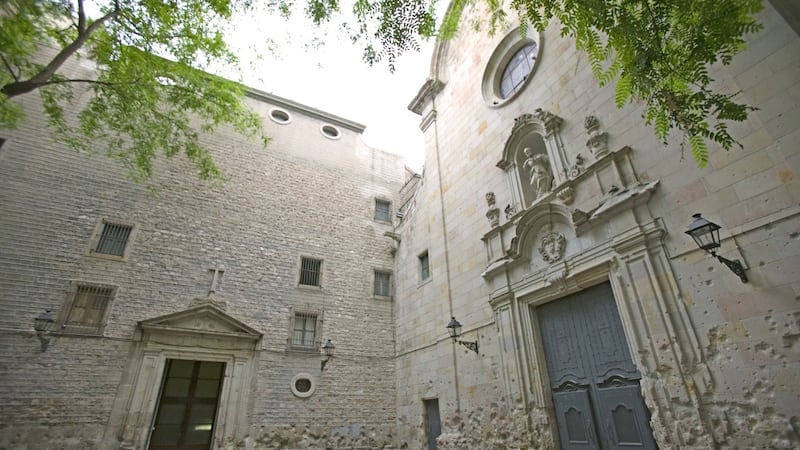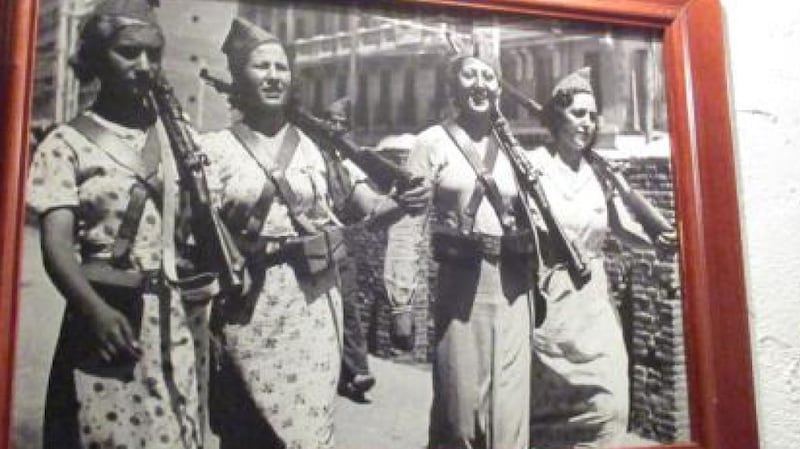"This is the first time an 11-year-old has dragged his parents to come on the tour," says Irishwoman Catherine Howley, who runs Spanish Civil War tours of Barcelona. A Trinity College graduate with a Master's in Museum Studies from Pompeu Fabra University in Barcelona, Howley has been revealing Barcelona's history for the past six years. The tours are based loosely on George Orwell's experiences during the conflict and his writings in Homage to Catalonia, and many of the group, including the Orwell-obsessed 11-year-old, have read his absorbing book. The book provides the framework for the tour. Where Orwell stayed, his thoughts and his military record are all discussed. The Barcelona of Orwell's experience is unrecognisable today and the tour rubs shoulders with the beer bikes and hen parties that are so popular in the city.
Our group is made up of all ages and nationalities. Howley, from Galway, explains that this is not a normal tour of the city. “There are layers and layers of history to the city – most people walk away from the tour remarking that they will never see Barcelona in the same light again and that they feel compelled to dig deeper, beyond the façade and into the more complex perspectives of its past.”
The tour reveals a painful and agonising side to Barcelona during the Spanish Civil War, which ran from 1936 to 1939. The alphabet soup-like groupings in Barcelona during this period are explained slowly and simply. Franco’s nationalists fought – and won – against the republicans, who had formed an alliance of convenience with anarchists, and it is this passionate history that has shaped Barcelona and Catalonia’s politics to this day.
Bloody battle
In the heart of Barcelona, where the tourists are catching their tours or reaching the top of La Rambla, there was a bloody battle. Dead horses in Plaça de Catalunya. Antagonists fought alongside each other to fight off Franco's insurgency. For a time, until Franco's forces entered the city in January 1939, Barcelona was a workers' city. Capitalism had disappeared. Howley reads out quotes from Homage to Catalonia that captures the mood in a city where everyone was equal and anarchism ruled. Tipping, for example, had been forbidden, and Howley reveals that Orwell received a ticking-off by a hotel manager for attempting to tip a lift boy. It's hard to imagine the huge banners of Lenin and Stalin that hung from the roof of what is now the Apple store on Plaça de Catalunya.

A few hundred metres from La Rambla, a haunting history of the city is revealed. At Santa Maria del Pi, Howley describes the thousands of clergy that were killed, a key motivation for Gen Eoin O'Duffy's Christian crusade from Ireland. Churches were ransacked and the remains of nuns desecrated. Some Irish newspapers supported Franco's insurgency and published articles detailing the grisly murders of nuns and priests. It's true there were horrendous murders, and the tour does not shy away from the anti-clerical violence that happened in Barcelona and across Spain. Howley passes images around the group on her iPad to whispered gasps and shocked faces.
Irish connections to the civil war are introduced on the tour. Irish soldiers volunteered for both the International Brigades and Franco's forces. Indeed, descendants of the volunteers have taken the tour, says Howley, including relatives of Charles Donnelly and Gen Eoin O'Duffy, and non-Irish tourists are surprised to hear that Ireland had soldiers on both sides of the conflict.
Italian air raid
In the small, cramped square of Plaça Sant Felip Neri there is a plaque dedicated to victims of an Italian air raid. Barcelona was heavily bombed by Mussolini’s air force. Mostly young children were killed in the square and shrapnel marks are still visible. On the tour, you never quite know what forgotten historical event could be lurking in the next square. These forgotten areas are often overlooked, says Howley, as we make our way through the narrow alley out of the square, but “when you build a narrative about the Spanish Civil War with the group you can then bring them to a gothic church from the 14th century and not just discuss the rose window of its façade . . . It becomes a very different reading of the building and its history.”

There is a tangible link, Howley argues in Bar Llibertària, where the tour finishes, between the Spanish Civil War and the second World War, that in part started in the streets of Barcelona. Bar Llibertària feels like a shrine to anarchism and has excellent tapas downstairs. Its walls are covered in photographs of a forgotten Barcelona and propaganda posters from the conflict – including Mickey Mouse and Popeye. Tourists are keen to learn, explains Howley, especially considering "the political situation in the US and Europe at the moment".
"I find the groups lately are really keen to reflect on the past and the importance of historical memory as to avoid the rise to Fascism that was witnessed in the 1930s." Not only did Franco's Fascist victory bring Spain into the Fascist sphere but some defeated Republican soldiers helped Allied forces fighting Nazi Germany. It was Republican soldiers who led the Allies into Paris. For them, the fight was not lost when Barcelona fell to Franco's forces in April 1939. The fight against Fascism continued.
Get there
Aer Lingus, Ryanair and Iberia fly to Barcelona from Dublin.
The Spanish Civil War tour meets in front of Café Zurich on Plaça de Catalunya. It takes four hours and costs €25 for adults, €11 for ages 11-15, under-11 free.










